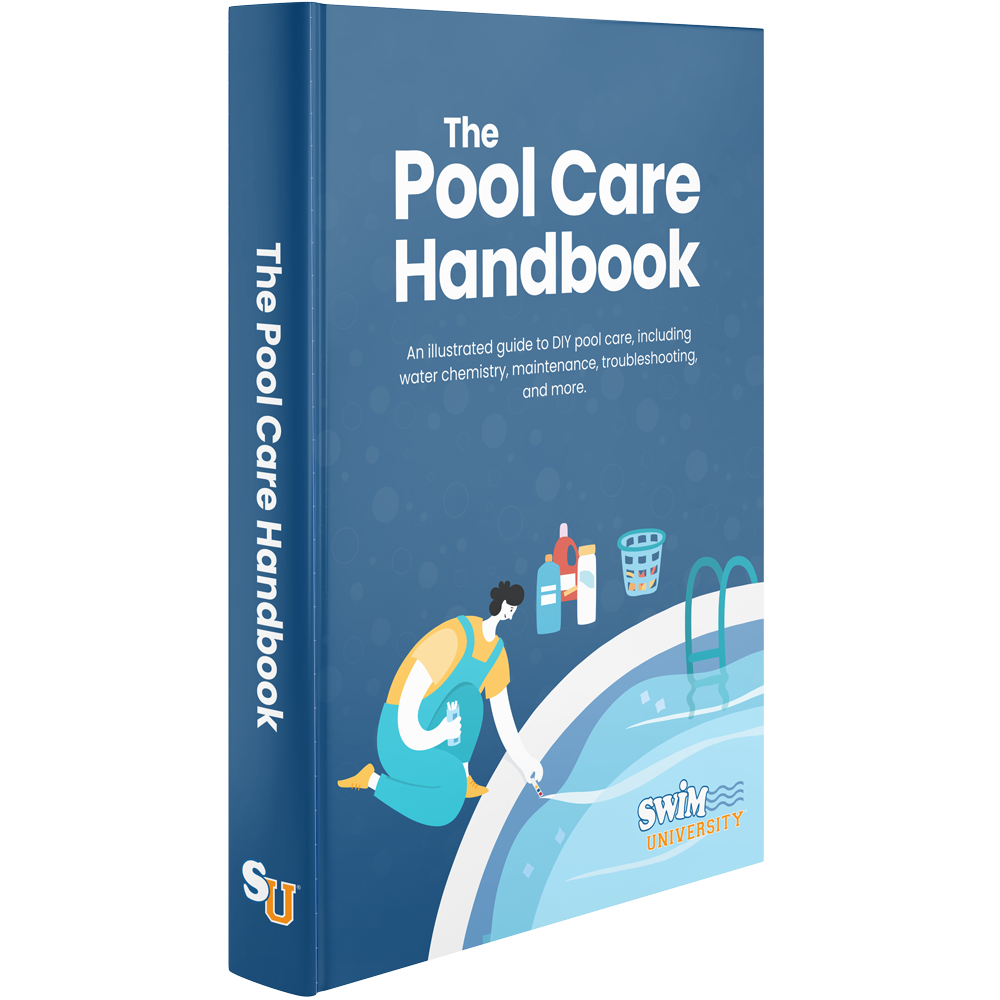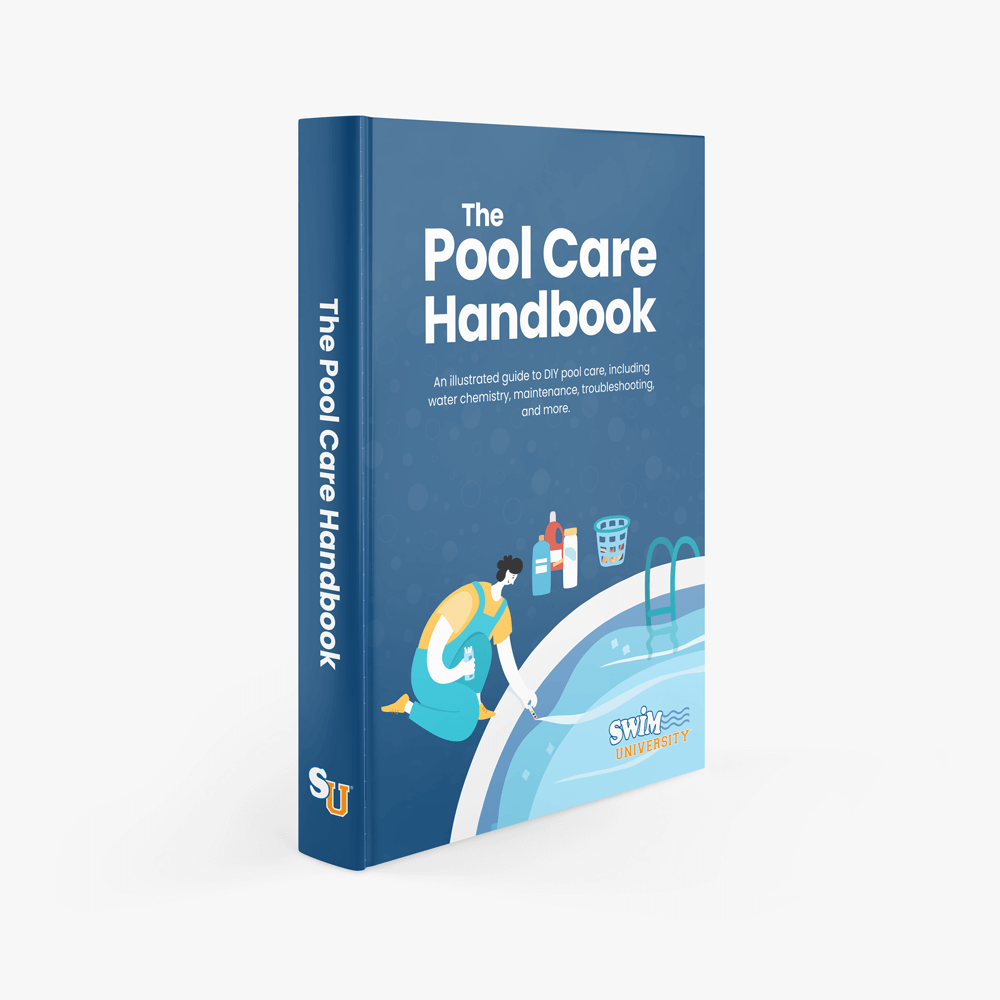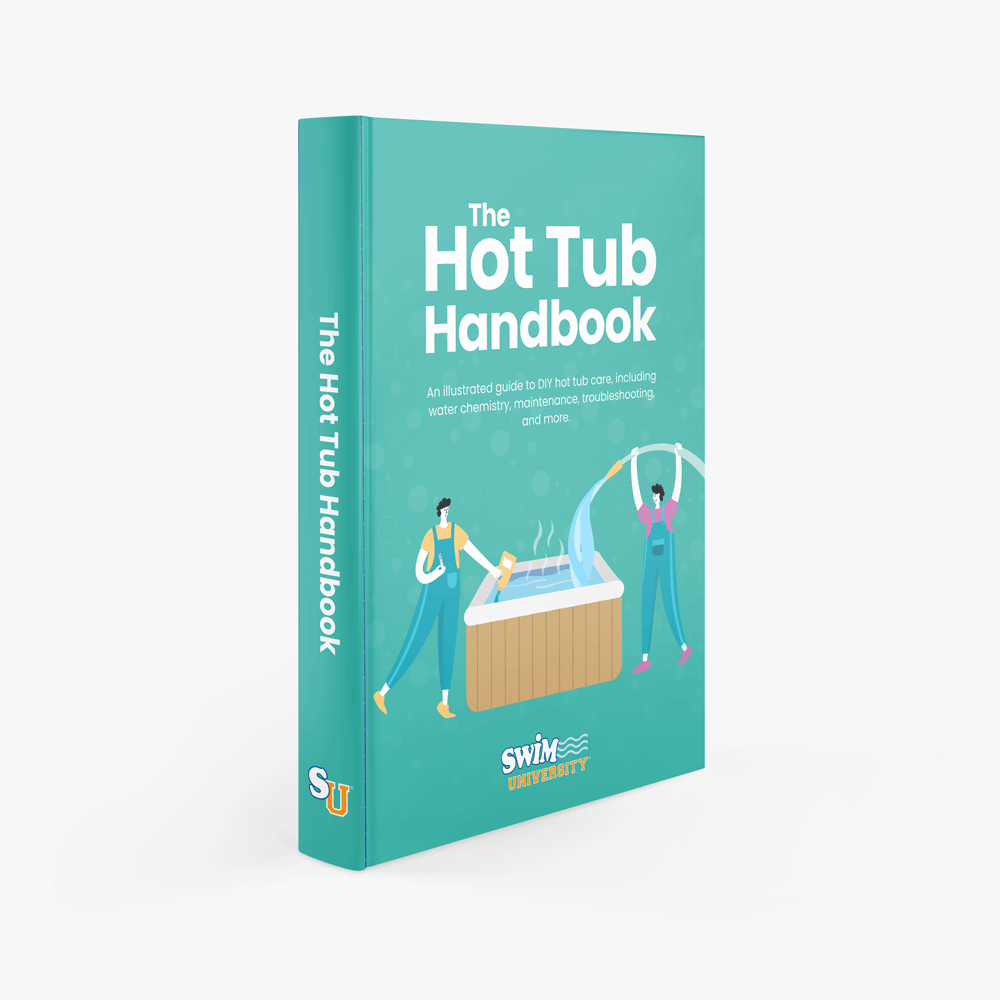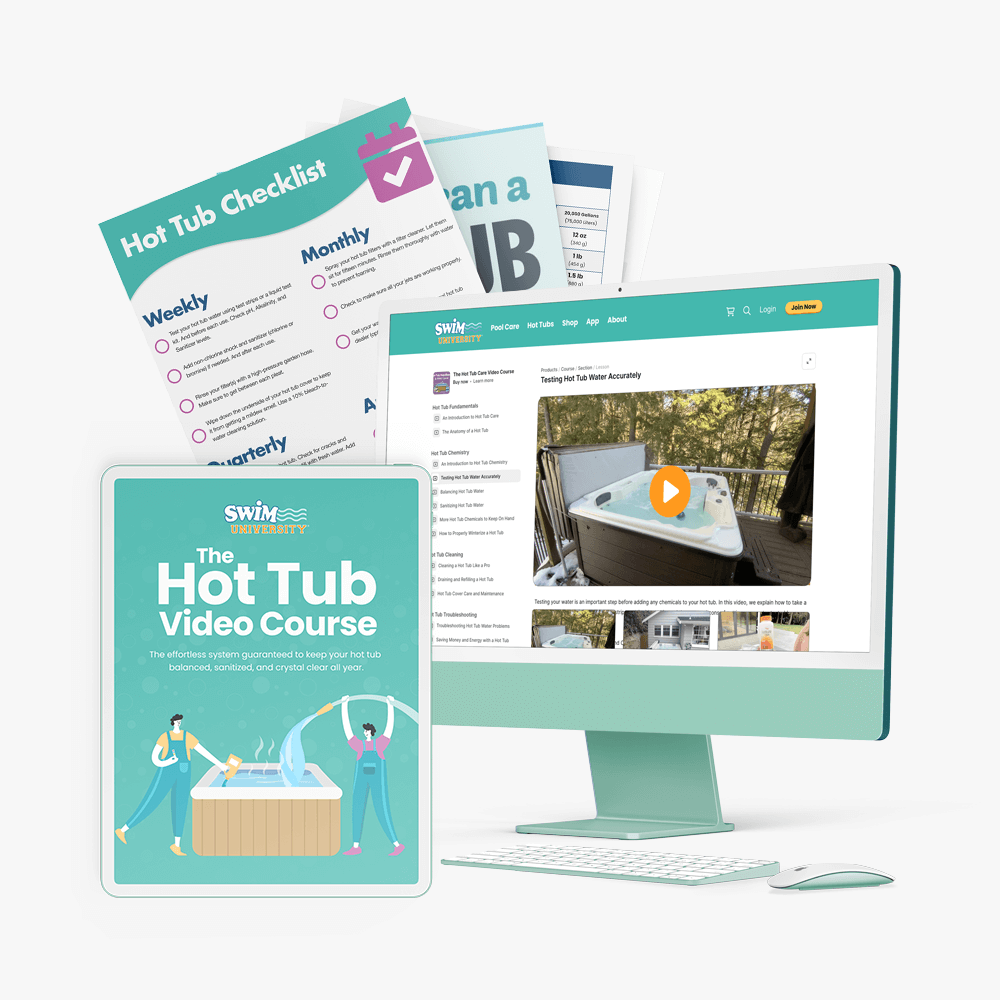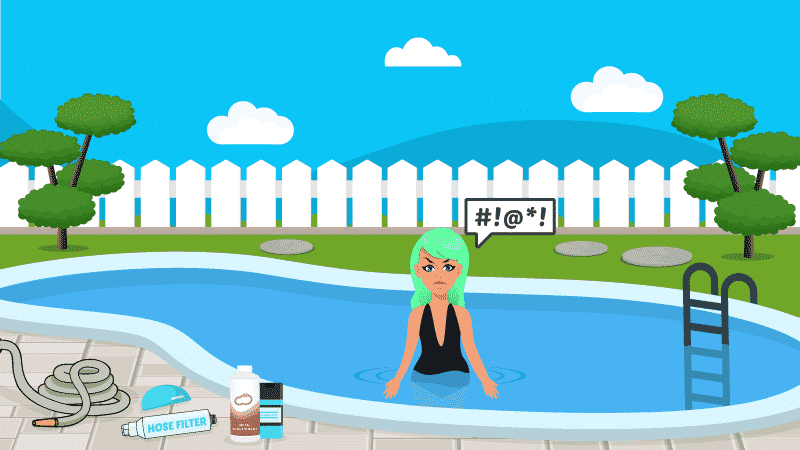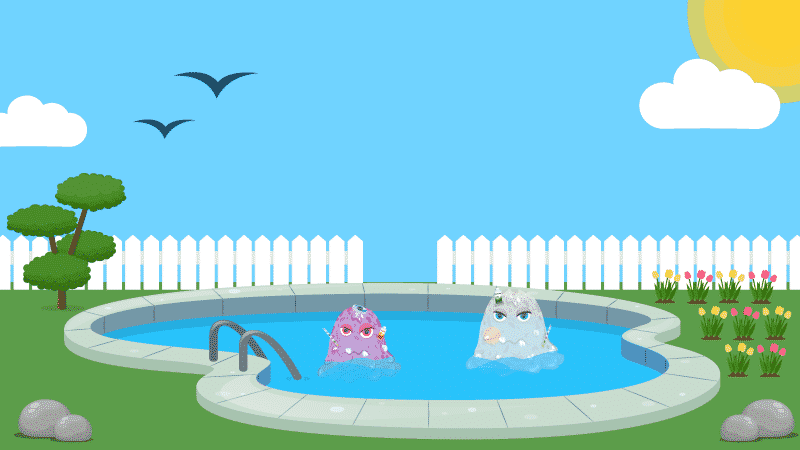How to Clear Cloudy Pool Water in 48 Hours or Less
Cloudy pool water is caused by 4 common pool issues: poor filtration, low chlorine levels, poor water chemistry, or contaminants in the water, like debris or algae. Here’s a step-by-step guide on how to fix these common issues, and how to clear up a cloudy pool fast using a clarifier or flocculant.
You can watch the quick video tutorial below. Or keep reading for the complete cloudy pool water troubleshooting guide.
This is the ultimate guide to keeping your pool sparkling clean throughout the year that contains everything you need to know about taking care of your pool the right way. Including saltwater pools.
4 Causes of Cloudy Pool Water And How To Fix It
Poor filtration, low chlorine levels, poor water chemistry, and outside contaminants cause cloudy water. Here’s how to troubleshoot each one of these issues.
1. Poor Filtration
Filter problems are the main cause of cloudy pool water. If your filter isn’t functioning properly, then it can’t remove the tiny contaminants that cause cloudy pool water.
SOLUTION: Keep your pool’s circulation system flowing with regular cleaning, maintenance, and run times. Check for the following filtration issues:
- Your pool filter has a clog or build-up. If you haven’t cleaned your filter in a while, it’s time to backwash your sand or D.E. filter, clean your D.E. filter grids, or clean the cartridge in your filter. Check out our pool filter cleaning walkthrough for more help.
- Your skimmer basket or pump basket is full of debris. Remove any leaves, twigs, or other debris in your skimmer or pump basket. If you’re frequently finding debris in your circulation system, take a look at our pool skimmer troubleshooting guide.
- Your pool filter media needs replacing. If your filter media is worn out or damaged, it won’t be able to capture contaminants that cause cloudy water. So every 5 years, change your filter sand or replace your cartridge filters every 2-3 years. If you have a D.E. filter, add fresh diatomaceous earth powder or replace your D.E. grids.
- You’re not running your filter long enough. To fix a cloudy pool, all of your pool water must run through the filter system at least once a day. You need to run your filter system for at least 8 to 12 hours a day.
- Your pool pump or filter needs replacing. As it gets older, your pool filter system can start to fail and you may need to replace major pieces of equipment.
2. Low Chlorine Levels
Pathogens, bacteria, and cloudy water form when there’s not enough chlorine to sanitize your water. Chlorine levels can drop if there’s lots of debris like leaves in your pool.
Also, if there’s a build-up of bodily contaminants like sweat or sunscreen, or if your water is exposed to the sun’s UV rays and your chlorine is not properly stabilized.
SOLUTION: Test your free chlorine and combined chlorine levels, add shock to rebalance your chlorine levels, and add cyanuric acid to stabilize a sun-exposed pool.
- Test your free chlorine levels. “Free Chlorine” is the amount of chlorine that’s available to sanitize your pool water. If these levels are low, you don’t have enough chlorine working in your water. To test for free chlorine, use test strips, a liquid test kit, or take a sample to your local pool supply store. If you have a chlorine or salt water pool, your free chlorine and combined chlorine should read between 1 and 3 ppm (parts per million).
- Calculate your combined chlorine levels. If your free chlorine levels are lower than your total chlorine levels, you can end up with chloramines. Chloramines are the byproduct of chlorine sanitizing which can be irritating and even corrosive. Your Combined Chlorine is the difference between your Free Chlorine reading and the Total Chlorine reading. Your combined chlorine should be below 0.5 ppm.
- Shock your pool with cal-hypo shock. To quickly bump up your free chlorine levels and remove chloramines, shock your pool using calcium hypochlorite shock. Calcium hypochlorite should be the main active ingredient in your pool shock (around 60 to 80%). Shocking your pool once per week during peak pool season refreshes your sanitizer levels and prevents cloudy water. If you need more help using shock, check out our guide on how to use pool shock.
- Test and add cyanuric acid if needed. Make sure you have the proper levels of cyanuric acid or CYA in your water. This will help prevent the sun’s UV rays from breaking down your chlorine too quickly. Your CYA levels should be between 30 and 50 ppm. Be sure to read our guide on how to balance your cyanuric acid levels.
3. Poor Water Chemistry: High pH, Alkalinity, and Calcium Hardness Levels
High levels of pH, Total Alkalinity, and Calcium Hardness can form scale on your pool surfaces and inside your plumbing. This can lead to pool filtration, bacteria growth, and cloudy water. And poor water chemistry makes it more difficult for your chlorine to function well and kill contaminants.
The proper pool water chemistry levels are:
- pH: 7.4 to 7.6.
- Alkalinity: 100 parts per million (ppm) to 150 ppm, with 125 ppm being ideal.
- Calcium Hardness: 175 ppm to 225 ppm for vinyl liner pools, or 200 ppm to 275 ppm for concrete and plaster pools.
SOLUTION: Test and balance your pH, total alkalinity, and calcium hardness levels.
- Test and balance your Total Alkalinity (TA) levels. Your alkalinity helps prevent fluctuations in your pH, so you’ll want to adjust these levels first. High alkalinity levels can cause pH and calcium scaling, which can cause cloudy water. To lower your alkalinity levels, use muriatic acid or a
pH decreaser . To raise your alkalinity levels, use an alkalinity increaser or baking soda. - Test and balance your pH levels. Improper pH levels can affect your chlorine and the other chemicals in your water. High levels of pH can cause calcium build-up and scaling which leads to cloudy pool water. Low levels of pH can cause your chlorine to become overly reactive and quickly depleted. This means it’s less effective at sanitizing, leading to a build-up of contaminants and cloudy pool water. You can lower your pH levels with a
pH decreaser . You can raise your pH with a pH increaser or soda ash. If you want more help balancing your pH and total alkalinity, check out our complete guide to basic pool water chemistry. - Test and balance your Calcium Hardness levels. High calcium hardness levels can cause calcium build-up and scale inside your pool plumbing and equipment. This creates a cloudy pool water problem that’s not easy to fix. If you have high calcium hardness levels, the only thing you can do is dilute your pool water. Partially drain your pool and refill with fresh water from a garden hose filter. Just remember that diluting your pool water will affect all of your water chemistry levels, so you’ll need to test your water again. For more help, check out our guide on how to balance your calcium hardness levels.
4. Contaminants, Like Debris or Algae
Contaminants, particles, and small debris in your pool can cause cloudy water. This is especially common during the springtime. Early-stage algae growth may also cause cloudy pool water.
SOLUTION: Treat algae in its early stages by cleaning and shocking your pool. Test, balance, and clean your water after a rainstorm or when debris or pollen accumulates in your pool.
- Treat algae. If you already have visible algae growth, you’ll need to get rid of your algae problem before you treat your cloudy pool water. Unfortunately, algaecide won’t solve the problem. It’s better as a preventative measure, not a treatment. To remove algae, you’ll need to skim, brush, and vacuum your pool. Be sure to bypass the filter by vacuuming on the waste setting. Then, you’ll want to shock your pool. If you need a step-by-step tutorial on getting rid of algae, check out our guide on how to get rid of algae in your pool.
- Test, balance, and clean your pool after a rainstorm. Storms can blow dirt and debris into your pool and the rain can dilute your pool water. That means your chlorine levels can drop, which we know can lead to cloudy water. Test and balance your water after a rainstorm and skim, brush, and vacuum the pool as needed. If you need to lower your water level, follow this guide on how to drain water from your pool after rain.
Stop wasting time and money with confusing water chemistry and maintenance. Our effortless system guarantees to keep your pool balanced, sanitized, and crystal clear all year. Works for all pools including saltwater.
If you’ve tackled these common problems and you want to fix cloudy pool water fast, you can use either a pool clarifier or pool flocculant (aka
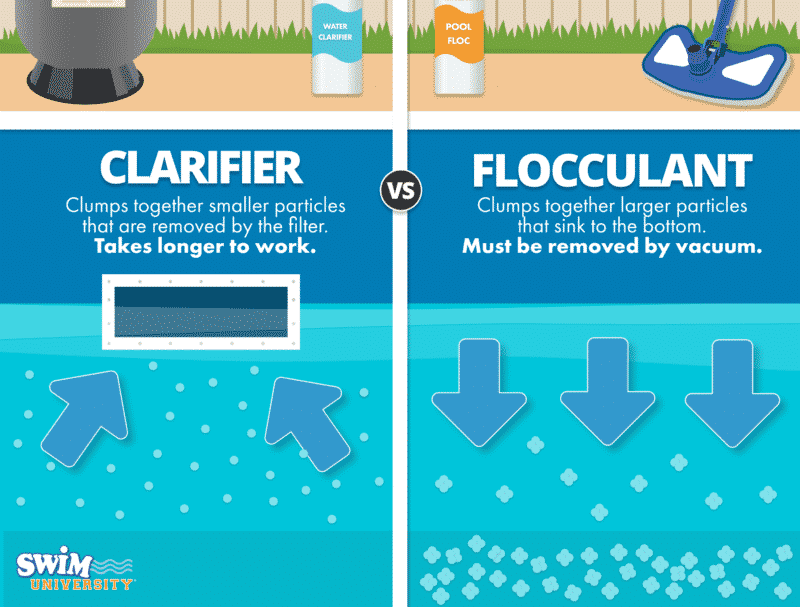
How To Use Pool Clarifier (Clears Cloudy Water In 48-72 Hours)
Pool clarifier uses your pool filter system to clear up the cloudy water. This is the easiest method for clearing cloudy pool water, but it takes a few days depending on your pool filter system’s power. A pool clarifier works with any filter type and works best with milder cloudy water issues.
1. Skim, Brush, and Vacuum Your Pool
Remove large debris with a heavy-duty skimmer. Brush your walls well with a stiff pool brush, then vacuum manually.
Do not use an automatic pool cleaner. It won’t properly suck up finer debris. Then vacuum your pool. But if you think you’ve got an algae problem, be sure to check out our guide on how to get rid of pool algae here first.
2. Test and Balance Your Water
Test your water with test strips or a liquid test kit. Test strips are easier and quicker to use but are less accurate than a good liquid test kit. Or you can take a water sample to your local pool store. Then, adjust your pH and alkalinity as needed until your water is balanced.
This complete water testing kit helps keep your pool or hot tub clean and safe to swim in, with easy-to-follow color instructions and all the supplies you need in one box.
3. Shock Your Pool
To eliminate any contaminants or chloramines in your cloudy pool water, add a high dose of chlorine by shocking your pool. If the cloudy water in your pool is due to a pool algae bloom, you’ll have to double or triple shock depending on the type of algae you have. And always shock your pool at dusk or night for maximum effectiveness.
Run your filter and let the shock dissolve overnight or for at least 8 hours. Then retest your water.
4. Run Your Filter 24/7
You’ll need to continuously run your filter over the next few days to help clear up the cloudy water. Then you can return to regular filter run times once your water is clear.
Your pool will clear faster depending on the type of filter you own. D.E. Filters, for example, filter out extra fine particles and will clear up cloudy water more quickly. If you have a cartridge filter, it will take a bit longer. If you have a sand filter, it will take the longest.
5. Increase Your Pool Circulation
Your skimmer located at the surface of your pool can’t get to the debris or cloudy water at the bottom of your pool. To help all of your pool water pass through your filter, you can increase your pool’s circulation.
- Position your return jets. Point your return jet(s) down at a 45° angle and all in the same direction. This will help churn the cloudy water up from the bottom of the pool to the top where your main skimmer can get it into your filter system.
- Use your bottom drains. If you have an inground pool, make sure the main drain at the bottom is on and is pulling water from the bottom of the pool into your filter system. This will speed up filtering and clear the pool water faster.
- Turn your vacuum upside down. If you have an above ground pool with no main drain, you can hook up your manual vacuum cleaner and turn it upside down at the bottom of the pool to mimic a bottom main drain.
6. Add Pool Water Clarifier
After your pool water has circulated and your shock has dissipated, it’s time to add your clarifier. Clarifier helps bind tiny particles into bigger particles that your filter can capture. Be sure to read the manufacturer’s instructions to make sure you’re adding the correct amount for your size pool.
Here’s our recommendation for a pool clarifier:
Clears cloudy pool water by combining particles, making it easier for your filter to remove. Great for all pools. Also compatible with salt water pools.
Clarifier works to clear mild cloudy pool water. Add it every other day as your filter runs until your water clears. If you have extremely cloudy water, you need to use a pool flocculant.
How To Use Pool Flocculant (Clears Cloudy Water In 24-48 Hours)
Pool flocculant, also known as
The coagulated particles cannot be removed by your filter, so you must be able to vacuum the water out of your pool while bypassing your filter media.
1. Balance Your pH
Test your water’s pH levels with test strips or a liquid test kit. Then, adjust your pH as needed, either with a pH increaser or
2. Add Pool Flocculant (Floc) Your Water
Pool flocculant binds the contaminants that cause cloudy pool water. Those large clumps then sink to the bottom of your pool. Be sure to read the manufacturer’s instructions to make sure you’re adding the correct amount of floc for your size pool.
Here’s our recommendation for a
A fast-acting formula that drops cloudy water particles to the bottom of the pool so you can vacuum it out. Safe for all pools.
3. Circulate Your Water
Circulate the pool water with your filter system for two hours. If you have a multiport valve, set it to “recirculate” to bypass your filter.
After circulating the pool chemical for two hours, shut off the filter system for the next 8-12 hours to let the particles settle to the bottom of the pool. Make sure your automatic timer doesn’t turn on in the middle of the night.
4. Vacuum Water Out Of Your Pool
You should now see a big cloud at the bottom of the pool. This means the
If you just vacuum your water through your filtration system, it’ll just blow right back in through the return jets. Instead, you have to vacuum the water out of your pool.
To do this with a multiport valve on your filter, just set it to the Waste option. This will send the pool water out of the backwash port as you vacuum. Keep a garden hose in your pool to refill your water while you vacuum.
If you don’t have a multiport valve, open the drain port on your filter and let it drain out as you vacuum.
Move the vacuum slowly along the bottom of the pool or else you’ll kick up the cloudy water. You may have to do this multiple times. Let the cloud resettle before continuing.
5. Test And Balance Your Water
Because you’ve removed water from your pool, you’ll need to rebalance your water chemistry. Test your pool water using test strips or a liquid test kit and adjust your Alkalinity and pH. Once you get those levels balanced, add your chlorine.
Now that you’ve gotten the cloudy water out of the pool, you can start running your filter system normally (8-12 hours a day or however long it takes your water to cycle through your filter at least once).
Frequently Asked Questions About Cloudy Pool Water
Looking for more help with your cloudy pool water? Here are some common questions and answers.
How long does it take for a cloudy pool to clear?
Depending on how cloudy your water is, it may take 2-3 days for your water to clear. If you’re using a clarifier, you’ll need to run your filter 24/7, keep your water chemistry balanced, and add the proper amount of water clarifier every other day until it’s clear.
What if my pool is cloudy but my chemicals are fine?
If your pool water is cloudy but your chemical levels are balanced, there are three likely reasons why:
- Your filter needs cleaning. A dirty filter can cause cloudy water. Check your filter’s pressure gauge, and if it’s over 10 PSI, it’s time to backwash or clean your filter grids.
- You just shocked your pool. After shocking, the dead contaminants will float in the water and cloud up your pool. You can use a clarifier or flocculant to clear up your water.
- You’ve got debris. Check and empty out your skimmer and pump baskets. And be sure to regularly remove debris with a skimmer net.
Once you tackle the root of the issue, you can use a clarifier each week to keep your water sparkling and clear.
Should you swim in cloudy pool water?
No, you should not swim in a cloudy pool. Cloudy pool water is full of contaminants and pathogens. There’s also an increased risk of drowning since swimmers can’t see the bottom of the pool.
Why is my pool cloudy after shocking?
Adding pool shock to an otherwise perfectly clean and balanced pool can even cause temporary cloudiness. This is common and it will dissipate over time as your filter runs. This can also happen if you use a cheaper shock. Be sure to use cal-hypo shock and read the instructions for the proper dosages.
Does too much chlorine make pool water cloudy?
High doses of chlorine, like pool shock, can cause temporary cloudiness as it kills contaminants. High levels of pH, alkalinity, and calcium hardness are more likely to cause cloudy water.
Will rainwater make my pool cloudy?
Rainstorms commonly cause cloudy pool water. They can wash contaminants into your pool water and the additional rainwater can throw off your pool water chemistry and lower your chlorine levels.
Will a cloudy pool clear on its own?
If your filter system is running properly and consistently, your chlorine levels are correct, your water is balanced and you’ve eliminated any algae growth, your cloudy pool can clear on its own. Otherwise, consider using a pool clarifier or
4 Ways We Can Help With Your Pool
- Pool Care Cheat Sheets (Free): Easy-to-use downloadable guides to help you keep track of taking care of your pool this year.
- The Pool Care Handbook: An illustrated guide to DIY pool care, including water chemistry, maintenance, troubleshooting, and more.
- The Pool Care Video Course: You’ll get 30+ step-by-step videos and a downloadable guide with everything you need to know about pool maintenance.
- The Pool Care App: Enter your water test results. Get a custom treatment plan. Know exactly what chemicals to add to keep your pool clear.

